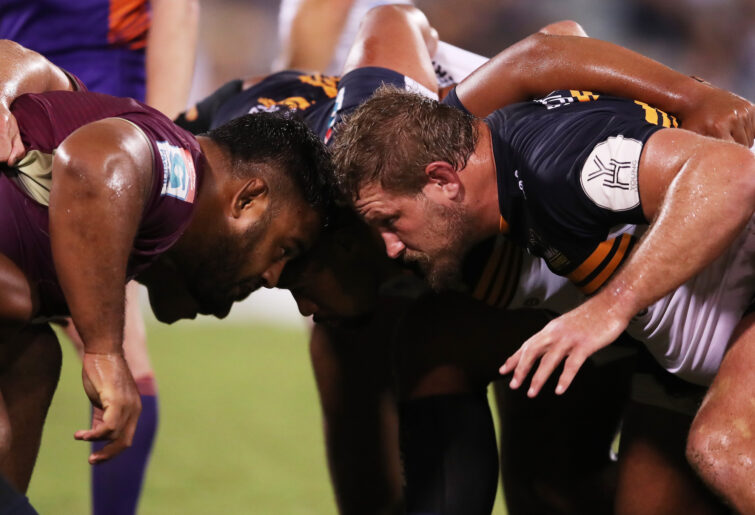I am sick of trying to explain to my NRL, AFL, and lapsed rugby union mates that the laws of NRL and AFL are framed by Australians who change their laws if such changes will improve their games as spectacles.
Whereas the laws of rugby union are framed by the Poms and others north of the equator, who see little need for changes while the existing laws suit their often boring styles of play, and while they can still fill Twickenham with styles of rugby that are often unacceptable to the Australian and Kiwi public.
I can recall watching the Springboks play the Wallabies at the Brisbane Ekka grounds back in the 1960s. The Boks had enormous lineout forwards, and under the international laws back then, they could kick the ball out on the full from any part of the ground, and more often than not win the subsequent lineouts.
Back then, in the ’60s, Australia was able to get a dispensation that allowed the ball to be kicked out on the full only from behind the 25-yard line. Thankfully the IRB later adopted that modification to the rule internationally.

(Photo by Richard Heathcote – World Rugby via Getty Images)
Currently I notice in the Six Nations that a red card awarded in the first minute of a game, or very early in a game, often ruins the game for both the red-carded player’s innocent teammates and for spectators by causing the penalised player’s team to play one man short for the remaining 79 minutes.
I just hope that before the Poms arrive here in July that World Rugby will have adopted the Super Rugby law whereby a red-carded player can be replaced by another player after 20 minutes or at least allow such a modification for the July Tests.
Any deliberate thuggery can later be dealt with severely by the judiciary, which might even include a life ban if serious enough.
As a high-school coach in decades past, I can recall stressing on the forwards that all eight of them should be able to be covered with a blanket.
There used to be an enlarged photo in their Crosby Park Clubhouse of eight Brothers forwards charging upfield, ball in hand, with only one opposition forward in that photo.
When the ball is given to the backs, they could mark centre upon centre, or wing upon wing, without defensive forwards cluttering up the back-line attack.
It was much more entertaining rugby, and at the time, Wallabies backs were known for their fabulous attack – even if they lost the forwards battle and/or the Test.
Anti-rugby folk, and most loyal rugby supporters, point to the following as some of problems with the modern game.

(Photo by Hagen Hopkins/Getty Images)
The first problem is off-side defenders, especially out wide, where such defenders are not behind the hindmost foot of the ruck or maul.
Now I am aware that referees (or, as I like to call them, ‘rougherees’) do not have eyes in the back of their head. But recently, touch judges were renamed as assistant referees.
Well, why don’t these assistant referees actually assist the main ref by alerting them to such off-side play that they may have missed?
Whenever I refereed a high school game, when both teams lined up on the halfway, I would tell all 30 of them that if I even thought that a player might be off-side, I would assume that he is off-side and that he would be penalised.
That attitude worked very well with teenagers – I am unsure how adult players might react?
Also, the purists might not agree, but maybe we should experiment with changing ‘behind the hindmost foot’ to, say, ‘five metres behind the hindmost foot’, at least to see if such an experiment provides better attacking play?
Forget about pinching from league.
Another issue is collapsed or reset scrum penalties. While an (often unintentional) crooked throw into the lineout is not allowed, why is a deliberate crooked feed to the scrum – often behind the prop’s feet – allowed?
In years past, such halfbacks were penalised. If the ball had to be fed straight into the scrum, then the hookers would need to strike for the ball – something that they cannot do today, because the front rows are packing too low, and therefore causing scrum collapses.
So make the scrumhalves feed the ball straight to eliminate many of the collapses (and subsequent penalties).

(Photo by Matt King/Getty Images)
Can anyone please explain to me why the driving maul, usually from lineouts, does not involve obstruction when the ball carrier has his own team-mates in front of him?
This is a real blight on the game. I would much prefer to see sparkling running tries than to see the boring, mobile wrestling that we so often need to tolerate.
Let’s rid our game altogether of this boring and possibly dangerous play.
Another problem is the the points-scoring system. It is over-debated, but seldom agreed upon.
Have we ever thought what is the most useless, and unwanted, rule in both rugby codes? The answer is the time-wasting conversion.
It is good to see that penalty tries, if justified, are now awarded seven points, without the need to kick the conversion.
How often do we see a team score more team tries than the opposition, but lose on conversions or penalties, which are the contributions of a single player?
So how about something like this, with no conversions. A team try is six points, a try from an often undetected off-side intercept is four points, a penalty goal for foul play (in addition to any card) or for major, or consistent, rule breaches is three points, a penalty goal for lesser breaches is two points, a field goal from beyond the half-way line is three or two points, other field goals are two or one points.
Finally, regarding time wasting, referees should ignore less serious injuries. Assistant refs can enter the field to advise if the injury is serious.
A stop clock to be involved (where available) for forming lineouts and scrums – timed from the whistle or from so many seconds after it, and for referees lecturing players, or when talking to assistant refs or to the TMO.
































































































